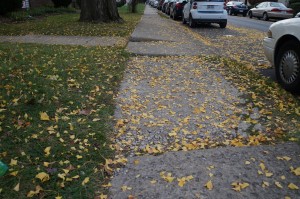When The Diamond Developers went through and scored the intersection of Tuttle Park Place and Norwich Avenue, the segment of Norwich Avenue up to High Street, and then the intersection of Norwich avenue and High Street, a total of 7/21 (33%) points were given. The main concern was the intersections, since neither provided any means of safely crossing. Both lacked a signal, a crosswalk, or any signage to alert drivers of the possibility of pedestrians. The segment on Norwich Avenue, however, was relatively safe to travel for pedestrians, but a lack of transit stops and bike path would prove to be an inconvenience for some people.
What was missing from the MAPS mini? What did you keep wanting to report, but didn’t find on the survey tool?
The MAPS mini useful in evaluating the sidewalks and the street crossings, but the group felt that a longer evaluation would do a better job in assessing the area. The group would have liked to see more questions on the walkability of not just the segment, but leading up to the segment. Specifically, parts of Tuttle Park Place is walking in the alley with no sidewalk, which the group wanted to report. Additionally, the group felt that some of the responses were too vague, and left too much room for ambiguity. For example, the responses for well maintained buildings had two options, 0-99%, and 100%. There was not a lot of room for a gray area.
Did you find public realm mattered more or less to you than private realm? Why?
The Diamond Developers feels that the public realm mattered more than the private realm in this survey. Most of the questions dealt with how the street and sidewalks are, with only one focusing on the buildings. The questions were focused on walkability rather than the aesthetics of the private property. This is good, since people walking and biking by would likely be more concerned with their safety than with how a certain house looks. A planner, in return, should focus more on the upkeep of the sidewalks and the safety in crossing streets.
What issues do you think would be more important to community members as opposed to planners?
The Diamond developers feel that community members would be more concerned with how the sidewalk is lit, how it is kept, and how they can cross a street. For people traveling, the group feels that they would be interested in how easy it is to get from point A to point B, more so than how the surrounding private property is. However, a planner may be more concerned with how the sidewalks interact with the private property, while keeping safety as a top priority.






 The survey also did not ask about what kind of commercial and residential uses the segment included. The use of the street can influence what should be in place there, and if it serves a purpose. The difference between the two should have an effect on how they are scored. The walkability to things such as parks and/or transit stops should be incorporated into the survey. While the need for a transit stop or park on every segment of street is not necessarily needed, the distance from one to the next should be considered. While the survey asked many questions, for several of the questions, a concise answer could not be given.
The survey also did not ask about what kind of commercial and residential uses the segment included. The use of the street can influence what should be in place there, and if it serves a purpose. The difference between the two should have an effect on how they are scored. The walkability to things such as parks and/or transit stops should be incorporated into the survey. While the need for a transit stop or park on every segment of street is not necessarily needed, the distance from one to the next should be considered. While the survey asked many questions, for several of the questions, a concise answer could not be given.  Throughout the segment the streetscape changes and the answers aren’t always clear-cut yes or no answers, but frequently could be both.
Throughout the segment the streetscape changes and the answers aren’t always clear-cut yes or no answers, but frequently could be both.